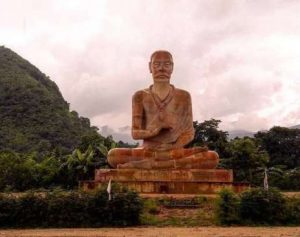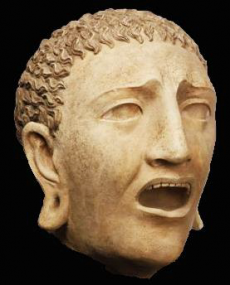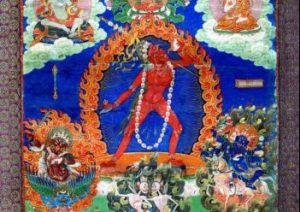
A time will come, the Buddha said, when the watery element will rise in fury, and when that happens, the earthly element will disappear, unmistakably revealing itself as transient and subject to ruin, destruction, and vicissitude . . .
A time will come when the watery element will dry and no water is left in the ocean that will cover just one joint of a finger. On that day, the watery element will unmistakably reveal itself as transient and subject to ruin, destruction, and vicissitude.
A time will come when the fiery element will rage furiously and devour the whole surface of the Earth, ceasing only when there is nothing more to devour. On that day, the fiery element will unmistakably reveal itself as transient and subject to destruction.
A time will come when the airy element will rage in fury and carry away village and town and everything on this Earth . . . ‘til it exhausts itself completely. On that day, this great airy element will unmistakably reveal itself as subject to transience and itself subject to ruin, destruction, and all vicissitude. (M.I. 187)
Everything composed of the four elements, including this Earth, shows itself as transient and subject to the law of impermanence (Pali: anicca), and this is as true for the four elements in the human body: matter, liquid, heat, and air, as it is true for any other body on this Earth. This is the law of the Dhamma.
Everything that is subject to arising is subject to ceasing. The body is born, lives, and dies in a process that is accompanied by physical pain at birth, during illness and suffering in life, and, unless we happen to pass away peacefully in our sleep, there is pain leading into the moment of death.
The Buddha says:
The corporeal form, brethren, is transient and what underlies the arising of corporeal form, that too is transient. As it is arisen from that which is transient, how could corporeal form be permanent? (SN 22/S.III, 23)
The components of the psychophysical elements of our body are also transient. We know that we must die and, therefore, we too are transient. Such a realization for most of us, however, is too painful to face full on, so we shove it aside, into the back of our minds, and continue to ignore it for the rest of our lives, inherently knowing we are hiding something from ourselves and suffering all the while.
Rather than live inauthentically in such “bad faith,” it is better to strive authentically, with determination of mind against the world of sham and delusion, by arousing the exceptional ardency and diligence needed to see clearly through the wrong view of worldly delusion to the base of truth and reality, which brings ultimate freedom from: first, ignorance, second, suffering and third, self. These are the Three Signata, which we often call the three signs or marks on the face of reality.
Paradoxically, we cannot even identify ourselves as continual receptors of impressions and feelings. Regarding what we may call our psychological selves, the Buddha, says:
Sensations and feelings are transient, what underlies the arising of these (such as the sense organs depending on the body) is also transient.
Arisen form is transient. How could sensations and feelings be permanent?
Similarly, perceptions, dynamic processes of the mind, and consciousness—all these, arising from what is transient, cannot but be transient. (SN 22:15/ S. III 23)
Simply put, trying to hang on to impressions identified with a sense of self, which we do not want to let go of, is an unsatisfactory feeling (Pali: dukkha), which is usually translated as suffering, but should also include a continuing sense of instability, uncertainty, incessant irritation, and dissatisfaction.
Furthermore, in the perceptions and the dynamic processes of the untrained mind, what is observed by the trained mind is seen as arising solely within mental formulations and then passing away as the impression or moods in moments of consciousness change.
In an oft-quoted dialogue, the Buddha asks:
What think ye, brethren—is the body permanent or transient?
It is transient, sir.
Now, that which is transient—is it satisfactory or unsatisfactory?
It is unsatisfactory, sir.
What think ye, brethren, sensation, perception, mental process, and consciousness—are all these permanent or transient?
They are transient, sir.
Now, what is transient—is that satisfactory or unsatisfactory?
It is unsatisfactory, sir. (SN 22:57)
Thus, a general state of “unsatisfactoriness” is the general state of the mind of mankind in this worldly world in which people frantically struggle to escape their feelings of uneasiness, dissatisfaction, and a perverse and pervading sense of general malaise, while vainly grasping at any fleeting external sensation and resultant expectation that may arise promising freedom from mental stress, from uneasiness and unrest; which promises some alluring satisfaction to momentarily “ease” the everyday state of mental “dis-ease,” in this ongoing, ever-turning dependent and conditioned world of samsara.
To quote Professor O. H. de A. Wijesekera: “The Master has said that the sentient being is so constituted that he hankers [for what is] pleasurable and shuns what is non-pleasurable. . . . He hankers after what is satisfactory for himself and recoils from what is unsatisfactory.” (Wijesekera 1987, 7)
Put simply, this means man selfishly seeks what is satisfactory for nourishing his needs, and when he does not get what he wants he feels dissatisfied and casts about in frustration and irritation, vainly trying to avoid dissatisfaction in the fulfillment of personal desires—often, consciously or unconsciously, at the expense of others.
We may now close by reading another well-known quotation.
The Buddha has said:
This indeed, brethren, is the Noble Truth of Dukkha, namely the fact that birth itself is dukkha, disease is dukkha, death is dukkha; to be joined with what is unpleasant is dukkha, to be separated from what is pleasant is dukkha; failure in getting what one wants is dukkha. In short, the five groups of the physical and mental qualities making up the individual due to grasping are themselves dukkha. (Vin. I. p. 10; S.V. 421)
Without an understanding of this Noble Truth of dukkha, the meditative practitioner will not make much progress on the path. The Buddha once summed up his teaching in one sentence:
I teach suffering and the end of suffering. (M. 22)
Moreover, if what the Buddha has said about impermanence and suffering are true, it follows that any sense that consciousness may cling to in the mind of itself as being a permanent self or entity is also delusory.
“Permanent consciousness,” in the Buddhist view, is a contradiction in terms based on wrong view—any conception that we hold about self is just plain wrong view.
References
Wijesekera, Dr. O.H. de A. 1982. The Three Signata: Anicca, Dukkha, Anatta. Kandy: Buddhist Publication Society Wheel Series 20.
See more
The Three Signata: Anicca, Dukkha, Anatta (PDF document; What the Buddha said in plain English)
Related features from Buddhistdoor Global
Rainy Day Contemplations on Suffering
The Sting of Suffering: The Scorpion and the Wasp












